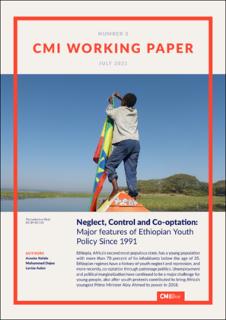| dc.contributor.author | Kefale, Asnake | |
| dc.contributor.author | Dejen, Mohammed | |
| dc.contributor.author | Aalen, Lovise | |
| dc.date.accessioned | 2021-07-09T16:24:12Z | |
| dc.date.available | 2021-07-09T16:24:12Z | |
| dc.date.issued | 2021-07-01 | |
| dc.identifier | oai:www.cmi.no:7829 | |
| dc.identifier.citation | Bergen: Chr. Michelsen Institute (CMI Working Paper WP 2021:3) 26 p. | |
| dc.identifier.isbn | 978-82-8062-778-0 | |
| dc.identifier.issn | 0804-3639 | |
| dc.identifier.uri | https://hdl.handle.net/11250/2764095 | |
| dc.description.abstract | Ethiopia, Africa’s second most populous state, has a young population with more than 70 percent of its inhabitants below the age of 35. Ethiopian regimes have a history of youth neglect and repression, and more recently, co-optation through patronage politics. Unemployment and political marginalization have continued to be a major challenge for young people, also after youth protests contributed to bring Africa’s youngest Prime Minister Abiy Ahmed to power in 2018. | |
| dc.language.iso | eng | |
| dc.publisher | Chr. Michelsen Institute | |
| dc.relation | CMI Working Paper | |
| dc.relation | WP 2021:3 | |
| dc.relation.ispartof | CMI Working Paper | |
| dc.relation.ispartofseries | CMI Working Paper WP 2021:3 | |
| dc.relation.uri | https://www.cmi.no/publications/7829-neglect-control-and-co-optation-major-features-of-ethiopian-youth-policy-since-1991 | |
| dc.subject | Youth | |
| dc.subject | Employment | |
| dc.subject | Politics | |
| dc.subject | Ethiopia | |
| dc.subject | Mozambique | |
| dc.subject | Uganda | |
| dc.subject | Zimbabwe | |
| dc.subject | Africa | |
| dc.title | Neglect, Control and Co-optation: Major features of Ethiopian Youth Policy Since 1991 | |
| dc.type | Working paper | |
